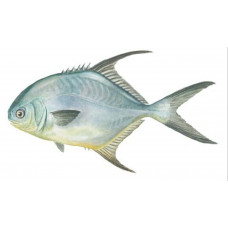Latin name
Trachinotus falcatus
Other names
French: carangue plume; Portuguese: sernambiguara; Spanish: palometa, pampano, pampano erizero, pámpano palometa.
Identification
In appearance, it is a shiny, silvery fish with dark fins and a dark or iridescent blue to greenish or grayish back. The belly is often yellowish, and occasionally the pelvic fins and anterior anal fin blade have an orange hue. Many specimens have a dark round black area on the sides behind the base of the pectoral fins, and some have a spot in the middle of the body. The body is compressed laterally, and the fish has a high back profile. Young fish appear rounded, while adults appear more elongated. The smaller fish have teeth on their tongue. They have 16 to 19 soft anal rays and 17 to 21 soft rays. The second dorsal fin has a single spike. They are distinguished by a deeper body and generally larger body size. Fish over 10 pounds have prominent second and third ribs and can be palpated through the sides of the fish, which helps distinguish them from Florida pompano.
Distribution
Found in the western Atlantic Ocean from Massachusetts to southeastern Brazil, including the Bahamas and much of the West Indies. They are most common in Florida, the Bahamas, and the Caribbean.
Habitat
These fish live in shallow, warm waters at depths of up to 100 feet, with juveniles preferring clearer and shallower waters than adults. Able to adapt to a wide range of salinity, they are found in channels or burrows on sandbanks, around reefs, and sometimes on muddy bottoms. When young, they are mostly schooling fish, moving in groups of 10 or more, although sometimes seen in large numbers, they become solitary as they age.
Size
They usually weigh 25 pounds and are 1 to 3 feet long, but can exceed 50 pounds and reach 45 inches in length. The world record among all tackle is held by a Florida fish weighing 56 pounds, 2 ounces, caught in 1997.
Life history and Behavior
No information
Food and feeding habits
On the sandy bottom, they feed mainly on mollusks and on reefs on crustaceans such as crabs, shrimps and sea urchins. They feed by rooting in the sand in shallow water.
Reproduction
No information
| Classification | |
| Phylum | Chordata |
| Class | Actinopterygii |
| Squad | Carangiformes |
| Family | Carangidae |
| Genus | Morone |
| Species | T. falcatus |
| Features | |
| Conservation status | Least Concern |
| Habitat | Pelagic |
| Life span, years | 23 |
| Maximum body weight, kg | 36 |
| Maximum length, cm | 122 |
| Sailing speed, m/s | No information |
| Threat to people | Edible |
| Way of eating | Predator |
Permit
Tags: Permit





